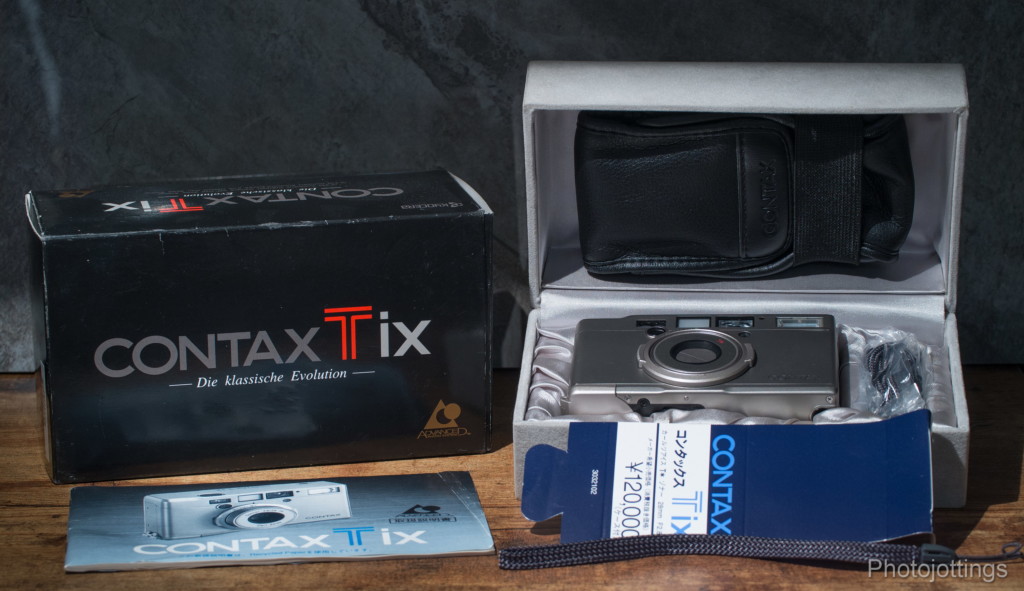
The Contax Tix was a super expensive “boutique” APS film camera that came out around 1997. I doubt there were many, (or any other) APS cameras that were more expensive than this one. Based on the hang tag of 120,000; street cost would have probably been about $999. A premium 35mm camera would’ve cost about the same amount, like this one.
The presentation case for the Contax Tix is so nice you would think it contained the Hope diamond. Rich people bought this camera for vacation snaps when it first came out. Starting around 2000 and later, digital cameras started taking a serious bite out of the film business , and the price dropped enough so middle class folks could afford a very nice sub-compact film camera. Unfortunately, a few years later, the film would no longer be made, and you wound up with a nice paper weight for your desk. It’s too bad because the Contax Tix is very small and convenient, with a lot of premium features and a really sharp Carl Zeiss Sonnar lens.
The Contax Tix is a sub-compact film camera, and uses APS film which has not been manufactured since around 2010-11. However, there is a bright spot for those that want to experiment with this state of the art film system. Currently, Amazon and eBay have some ‘cold stored’ film available here Amazon, eBay, and that’s mostly what I’ve used for this review. Note: do not buy color film with an expiration date unless you’re sure it has been frozen, otherwise it probably won’t turn out; B&W seems to be good based on a couple of rolls I purchased in 2017. When shopping online, be sure you buy film that says something similar to ‘cold stored’ or ‘bulk rolled from refrigerated stock’ and guaranteed etc. I’ve had good luck lately from a dealer called 21supply using Fuji Nexia A200 15 exposure rolls. Currently available Kodak film turns out too red.
With the introduction out of the way, let’s check out the Contax Tix specs.
Name; Contax Tix, silver or black.
Manufactured by; Kyocera Corporation, Japan.
Date of manufacture; ca1997, made in Japan.
Price; originally around $999 new, or 120,000 yen. Current eBay prices range anywhere from $150 to $250 depending on condition.
Build material; appears to be a mix of mostly metal, and a small amount of plastic.
Box contents; Plush presentation case, Neck strap, wrist strap, instruction manual in multiple languages, lens hood, and a vinyl softcase.
Weight; camera only, 8.0oz (225g).
Dimensions; 4.0″ (100.5mm) wide, 2.4″ (60.5mm) tall, and 1.3″ (33mm) deep.
Focal length; 28mm. In the ‘C’ mode, the camera ‘sees’ horizontally about the same as a 42mm lens in 135 format, and about 34mm in ‘H’ mode.
Aperture; F/2.8-F/16 automatically set in ‘P’ mode, or manually set by turning the front ring around the lens.
ISO; 25-10,000 automatically set in 1/3 stops.
Focusing distance; 14″ (.35m) to infinity. You can’t manually focus the lens, except in ‘landscape’ mode, which sets the focus to infinity.
Prints; you could set the camera to any crop mode at any time, even mid-roll. So whatever setting you chose, like ‘C’ or ‘H’ for instance; the shop would print your photos in that aspect ratio, even though the whole image, (‘H’) was on the negative.
Approximate resolution; good film will make very sharp 8×10″ prints in all modes. See sample images farther down the page.
Lens; 28mm F/2.8 Carl Zeiss T* Six element in four group Sonnar design.
Viewfinder; pretty bright with info along the bottom. The changes in aspect ratio for C, H and P only moves the guide lines, not the viewfinder coverage. Reverse galileo type, externally illuminated bright-frame viewfinder with automatic LED illumination under low-light conditions. Focusing frame; close-up parallax correction frame; picture area frame, (switchable in accordance with selected C, H, P aspect ratio); focus indicator, exposure compensation indicator; flash indicator, program display. Magnification 0.5x and print coverage field of view, 85%
Shutter and speed; double “between type” shutter, 15 seconds and 1/1000 sec, automatically set; and only 1/500s at F/2.8.
Features; Fill flash, Red eye reduction, slow sync, auto, and flash off options. Mid-roll rewind only, there is no mid-roll change option. Ten second self timer. Date imprinting to year 2029, goofy title selections like happy birthday, I love you and all that baloney.
Film; 30.2×16.7mm native picture size, IX240 APS leaderless thrust cartridge film available in 15, 25, or 40 exposures, Amazon, eBay
Flash; recharge in about 3 seconds, range of about 6.9′ (2.1m) with ISO 100 speed film. Operates at 1/60s in auto flash mode.
Magnetic data recording; basic information: date; time; C-H-P print aspect ratio, Print quality improvement Information (PQI): exposure information: f stop; shutter speed; exposure compensation value, title recording: selectable from a total of 54 titles (9 title items in 6 languages).
Power; CR2 3V lithium. Manual states the battery will last for 20 rolls of 25 exposure film.
Accessories for this model; A lens ring adapter with a few filters like an L39 UV, A2, B2, 81A, 82B, and a lens cap. Also a CC-67 semi hardcase.
Crippling features and omissions; nothing gets in the way, and nothing is missing that would be important.
Good features; shutter speed indicator, spot focusing mode and infinity focus lock. Exposure compensation is the most important feature on any APS camera because you’ll be using expired film, which requires about two extra stops of light as opposed to fresh film. The Contax Tix can go up to +2.0 in continuous mode, or +1.5 in single.
Product shots with descriptions.

The front of the camera has quite a few things to point out. The lens has a built in protective cover that opens and closes when powering the lens on or off. The grips on the sides are for setting the aperture by turning the ring. The large round button on the left is the AF infrared assist beam, the smaller one on the right is a light meter. There are four rectangular openings along the top of the camera. The left most one is an autofocus window, the one to the right of that is the viewfinder illumination window, then comes the actual viewfinder window, and the last one to the right is the flash. The tiny round LED between the flash and viewfinder is for the self timer indicator.
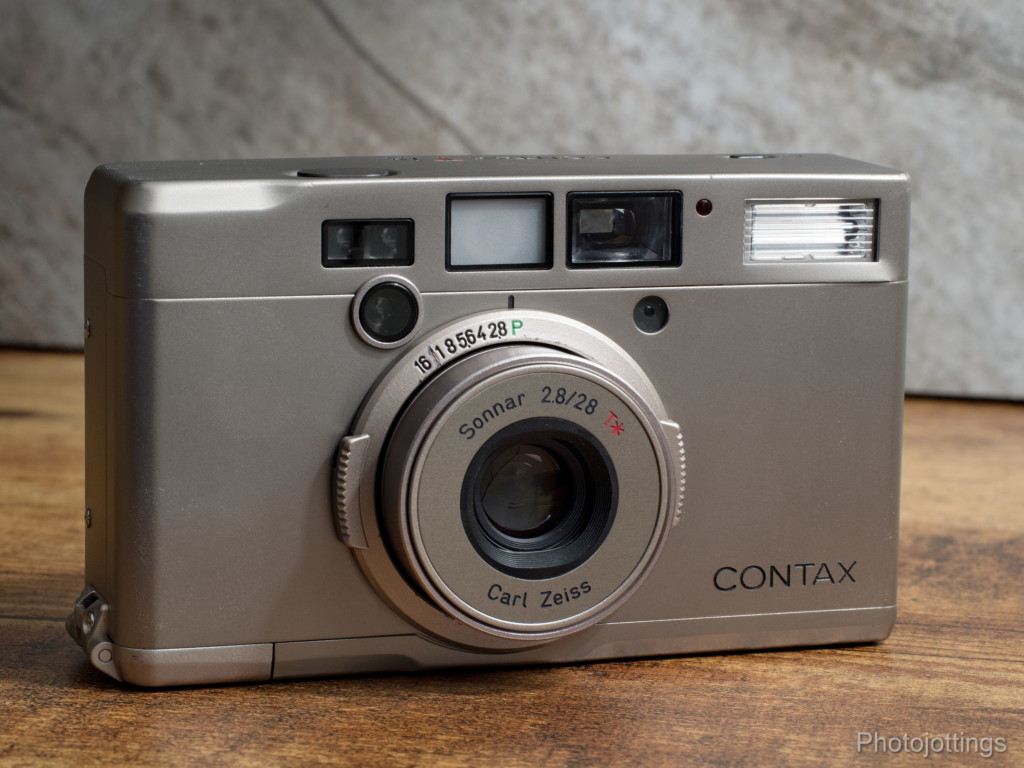
When pressing the power button the lens takes 1 second to extend and is ready to shoot.
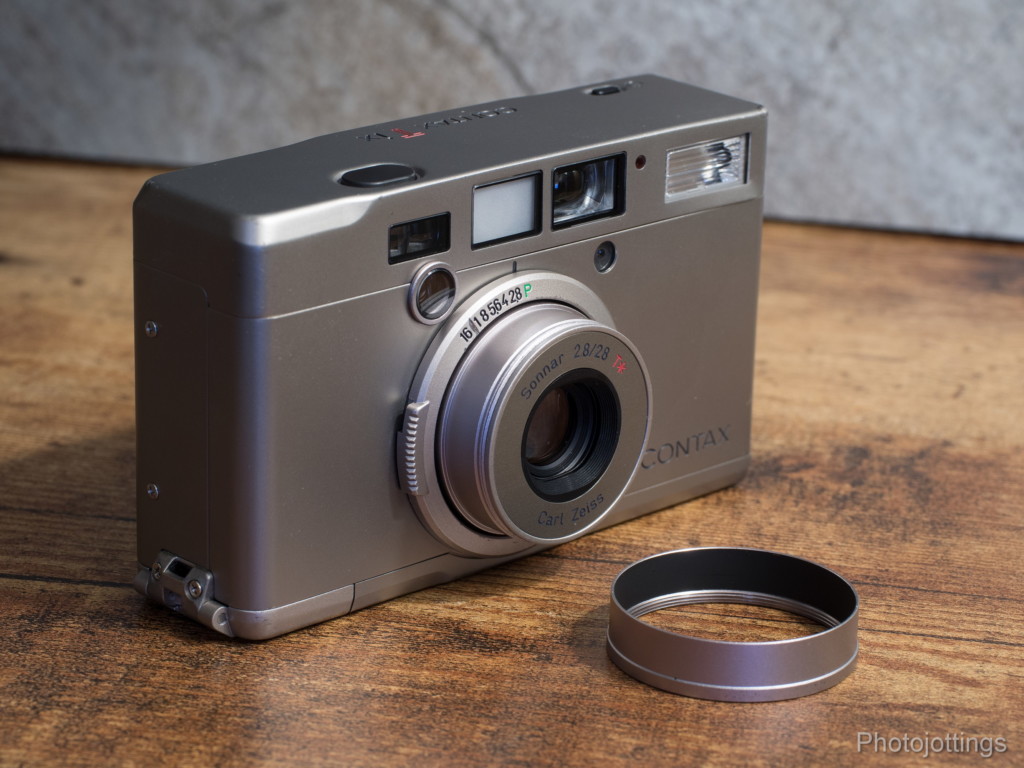
There is a lens hood that screws to the lens both ways. Facing inwards for storage, see photo above, and outwards for taking pictures in the sun.
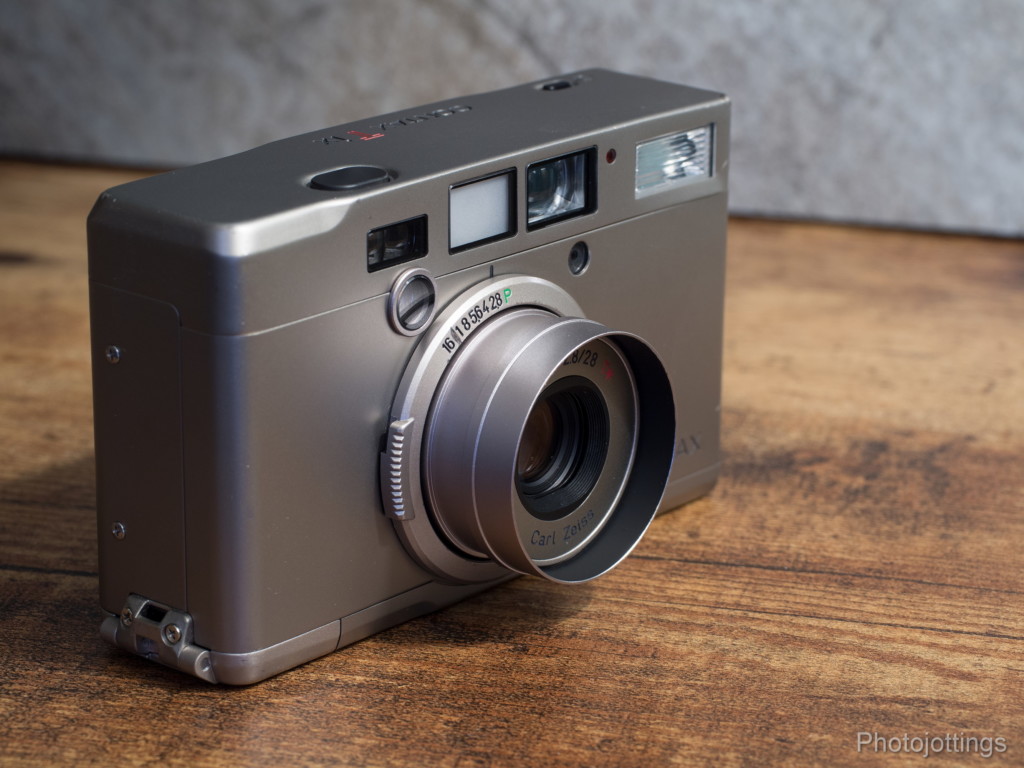
Fired up, lens hood attached, and ready to shoot!
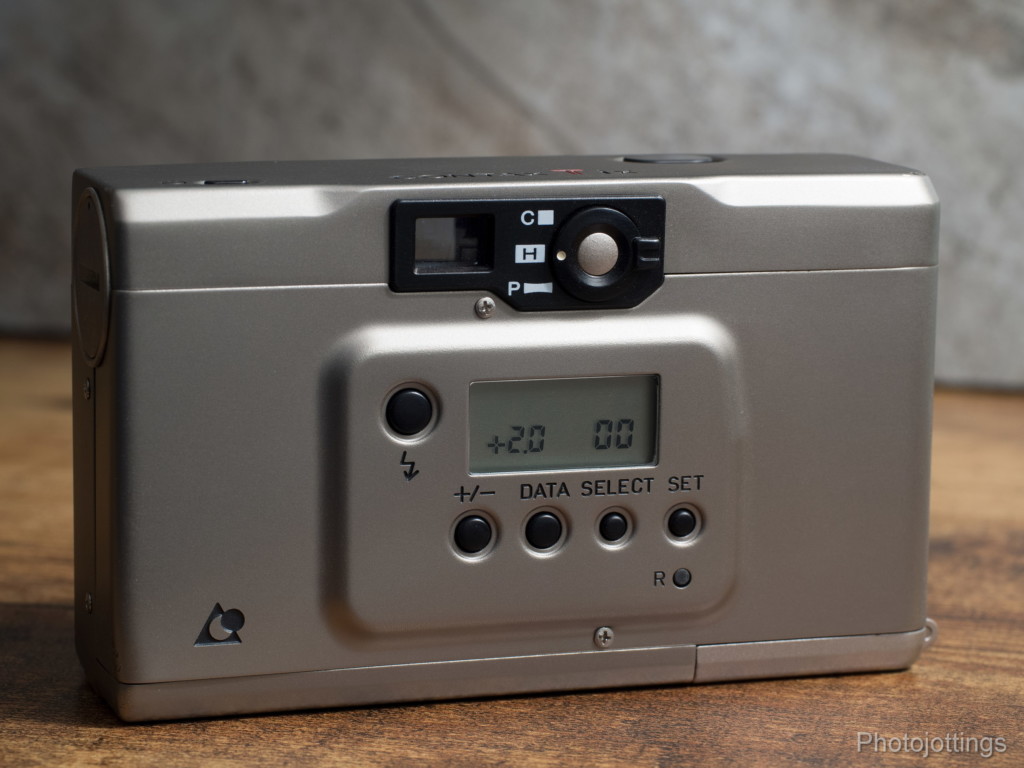
On the back we have our choices of aspect ratio (or print format), either ‘C’ ‘H’ or ‘P’ selectable using the switch. Hidden in the middle of the switch is the power button; when I first received the camera, I actually had to refer to the camera manual to see how to turn it on, it’s the first time I ever had to do that!
Directly in the middle is the display panel and various buttons. The large button top/left is for selecting flash options. The +/- is for exposure compensation, notice I have it set at +2.0, that’s what you’re going to have to do when you use old film, which is your only choice as of this review. The “Data” “Select” and “Set” buttons are for time, date, exposure info and titles. The little button with an “R” is for manually rewinding the film.
Hard to see in this view but the single 3V CR2 battery goes inside the circular coin slot cover on the upper left side.

On top we have a small self timer button on the left, and the shutter release on the right. There is no cable release.

The film compartment door and latch is on the bottom of the camera. Notice the extremely offset tripod socket on the right.

The Contax Tix is noticeably smaller than the Nikon 35Ti, and in my opinion, much easier to use, with the same basic feature set.
Let’s move on to some samples now. All were taken with long expired Fuji Nexia A200 film, and some color layers have gone bad over the years, but you could always convert the pictures to B&W if you think the colors are awful. Scanned on a Nikon Coolscan 9000 ED and presented about 2800 pixels wide, which would be about the same as showing 35mm film at 4000 pixels wide. Click images for larger versions.

Home on the range. It’s very sharp over the entire frame. I see a noticeably magenta cast to the picture. Click for larger image.

High afternoon sun in the picture, along with some flare; however, contrast is pretty good.

Here is a scan of the entire negative. You can see the recorded read area at the top. This is cold stored Fuji Nexia A200.
Test images next. The film color here is not so great, and I took them mid-day, so the lighting is harsh, but I needed the shutter speeds to be high enough to hand hold at F/8-11 for sharp shots, rememeber, I had to use +2.0ev for the film to come out right.

This one is at F/2.8; it’s just a bit soft, but totally usable. Click these for larger size.

Moving to F/4 sharpens up the entire frame, at which point the centers are maxed out in resolution.

Stopping down to F/5.6 sharpens up the extreme sides. The lens gets no sharper anywhere in the frame by stopping down, so F/5.6 is your best landscape aperture; depth of field may be another issue though.

This one is at F/8, which looks almost identical to F/5.6.

At F/11 the image starts to soften up a bit.
Conclusion.
The Contax Tix is certainly one of, if not the best sub-compact film camera ever available, in any format. Ergonomics are surprisingly good for a small camera; maybe a little ‘slippery’ in the hand but it slides in and out of your pocket quite easily. Of course, the Carl Zeiss Sonnar lens is first rate, and one of the best lenses I’ve every used. It also has an excellent feature set; including manual aperture settings; a shutter speed indicator on the display panel; exposure compensation, an abundance of flash modes, and a built in reversible hood, which also facilitated the adapter for filter use; unheard of in a sub-compact camera. Rounding out the most notable features is the very accurate, and fully automatic “P” program exposure mode.
It really is a shame that film is no longer being freshly made for the APS format. The Contax Tix is a dream come true for film lovers looking for a small pocket camera that delivers high end results; It’ll give you nice 8×10 prints, and who really displays anything much larger? In fact, this camera will easily out resolve all the cheaper 35mm cameras with 3 element anastigmats, 4 element tessar type lenses, and even some of the 6×6 box cameras like this one.
Oh well, the best sub-compact film camera ever now serves really just as a paper weight or display item. I had fun running a half dozen rolls through it, but I’ll probably put it back in the box after this review is finished and dream about what could have been were it not for digital cameras coming out about the same time. If you feel adventurous, by all means get one yourself and give it a try with some cold stored film.
A sad side note; I dropped this mint condition camera twice within 30 seconds shortly after I received it while taking test pictures, and man did it hit the ground hard. Other than a few scratched, it worked just fine. This is the first camera in my life I’ve every put a mark on or dropped!! I was out walking the dog on a leash with one hand, and taking pictures with my other hand, and of course the dog saw a rabbit or bird and jerked the chain while I had the camera up to my face; twice!!
That’s it for this review, thanks for stopping by!
Go here for the English users manual, and be sure and tip the site owner.
Below is the same information from the Canon Elph Jr review.
Cold stored film available here, Amazon, eBay. I’ve used Fuji Nexia 200 for the color pics here, but have also successfully used Kodak Advantix 200, (but not lately). Kodak B&W (C-41) long expired film seems to work well, even if it wasn’t cold stored.
Note: do not buy color film with an expiration date, it probably won’t turn out. Be sure you buy film that says something similar to ‘cold stored’ or ‘bulk rolled from refrigerated stock’ and guaranteed etc. I’ve had good luck lately from a dealer called 21supply using Fuji Nexia A200 15 exposure rolls. Currently available Kodak film turns out too red.
Developing; your local photo developer may not want to process your APS film because they don’t have the proper scanning masks or holders, and can’t print properly from the film data. Fortunately, you can tell them to just develop and sleeve the film, the same as they would do with 35mm film, and then use your flatbed scanner to digitize your negatives. In the past I’ve used an Epson V700/V750/V800/V850 scanner (B&H, Amazon, eBay) with this holder.
A little info on the APS film format.
The Advanced photo system was a completely new type of film format that came out in 1996; it was smaller than 135 type, (typically called ’35mm’), and larger than 110 film, which was popular in the 1980s.
The film was stored in a cartridge, and had no leader, so there was no threading or laying the film across the sprockets in hopes of it catching and moving forward as you did with 135 film type. You just inserted the cartridge, closed the door, and the camera would advance the film as you took pictures, and rewind it when the last picture was taken. All APS cameras had automatic film winding and ISO settings.
Neat features include visual exposure indicators on the top of the cartridge; see the picture above: an optical strip, (cheap models), or magnetic IX strip (better models), along the film bottom would include certain settings like print type, C, H or P for example, and maybe camera settings on more advanced models. When you were done shooting, the film was automatically wound back inside the cartridge, and you took it to the shop for development and prints. The APS film format also incorporated a protective feature that stored the negatives inside the original cartridge. So when you got your negatives back, they were inside the cartridge; if you wanted to know what pictures were inside, you looked at the index print provided by the developer, which included a number that matched the cartridge to the index print.
The Advanced Photo System was very innovative, and actually pretty cool; it was a nice try; however, it was also too little, too late as they say. By the late 1990s, digital was starting to become affordable, and quality was quickly improving each year. By the mid 2000s, the APS format had one foot in the grave.